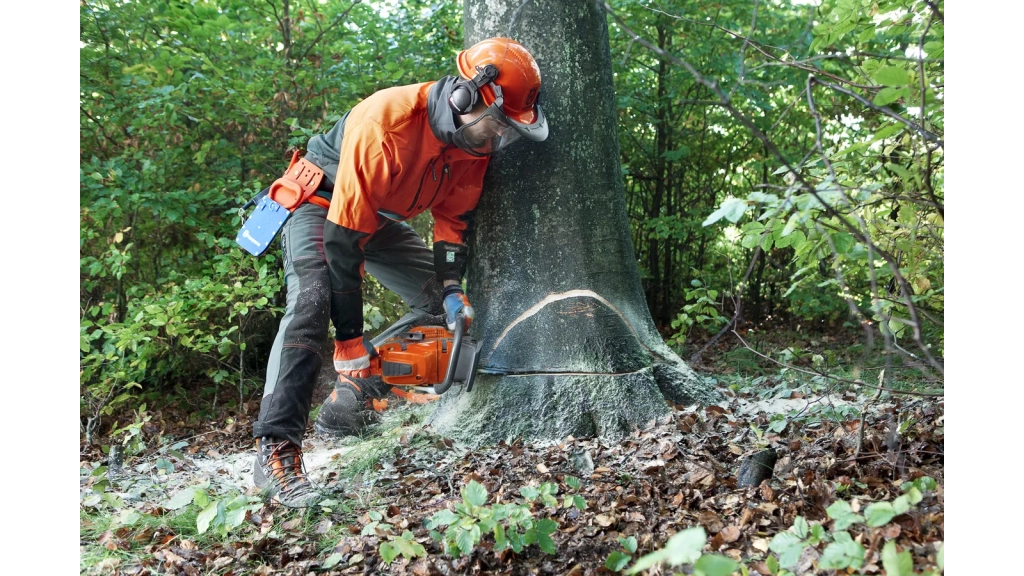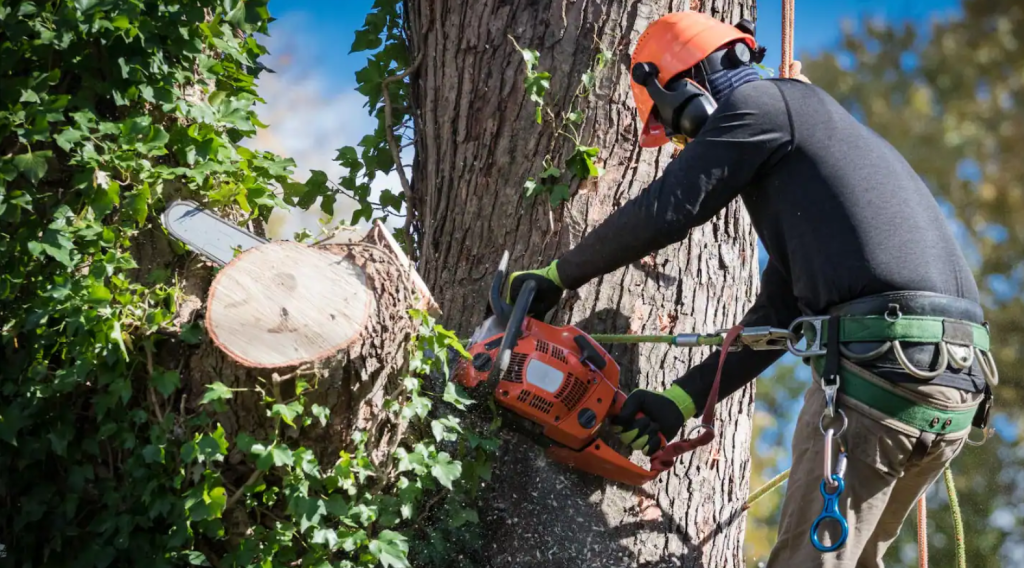If you live along Colorado’s Front Range, you already know trees don’t play by the same rules here. Spring storms drop heavy, wet “snow bombs” that bend even sturdy branches. Beetle-kill and drought stress create hidden weaknesses, and plenty of homes sit on slopes or tight city lots with no margin for error. So the big question, should you remove a tree yourself, doesn’t have a one-size-fits-all answer. Sometimes a small ornamental in the middle of an open yard is a perfectly reasonable DIY. Many other times, it’s a fast way to damage a roof, tangle with a power line, or get hurt.
If your tree is small (under about 6–8 inches in diameter at chest height), healthy, single-stemmed, and has a clear place to fall far from fences, cars, and wires, you might be okay. If it’s bigger, close to structures or roads, part of a multi-stem tangle, dead or diseased, on a slope, or anywhere near utilities, it’s time to call in a pro. Not sure which way you’re leaning? Send us a photo for a same-day opinion.
Why the Front Range Is a Special Case

Weather & Terrain
Wind is our wild card. Canyon gusts can swing a falling tree a few degrees off course without warning. Add heavy spring snow and icy branches, and cuts that behave predictably elsewhere can do something entirely different here. In the foothills and I-70 corridor communities like Golden, Evergreen, Genesee, and Idaho Springs, slopes and rock outcrops complicate footing and create rolling hazards once a trunk hits the ground. Inside Denver and Boulder, older neighborhoods and narrow setbacks leave almost no room to work.
The Species Factor
Tree behavior is species-specific. Cottonwoods are iconic along creeks and alleys, but their limbs are large and brittle, and their size often demands cranes or sectional rigging. Ponderosa pines grow tall with long, wind-catching levers; on slopes, they’re notorious for surprising swings during felling. Blue spruce and Douglas-fir pack a lot of dense weight in the crown, which can pull in unexpected directions. Aspen often hides decay and has weak unions; what looks simple can shear early. And then there’s ash: with emerald ash borer now a reality along the Front Range, an ash that still looks “green” can be structurally unreliable. That’s not a great candidate for a Saturday DIY.
Tight Urban Logistics
Even when the tree seems manageable, the work zone may not be. Alleys, sidewalks, bike traffic, and on-street parking are part of daily life in Denver and Boulder. A decent plan on paper can become unworkable once you account for pedestrians, dog walkers, delivery trucks, and city-maintained right-of-way trees.
Legal & Compliance Checklist (Don’t Skip This!)
Every city and HOA is a little different, but a few rules of thumb will save headaches. Many street and right-of-way trees fall under city authority in Boulder and Denver. If your tree lives between or hangs over the sidewalk and the street, you may need a permit and a licensed professional to touch it. Historic districts and HOAs sometimes require approvals for tree removals that are visible from the street.
Utilities are a hard line. If a branch or trunk could reach an overhead electric line, it’s never a DIY project. Utility vegetation rules are strict for a reason, and violations are dangerous and expensive. Below ground, “Call 811” isn’t just a slogan. If you’re stump grinding or working around roots, it’s the safest way to avoid gas and water laterals.
Wildlife rules matter too. Nesting windows for migratory birds can temporarily limit what you can do, especially in spring and early summer. Some removals are easier in late fall and winter when foliage is down and wildlife activity is lower, but storm emergencies don’t wait for ideal timing.
If all of this sounds like a maze, that’s because it can be. Not sure about permits? We’ll take care of all the technicalities and compliance factors!
DIY Tree Removal, Step-by-Step (For Small, Simple Trees Only)

If your tree truly qualifies as low-risk, here’s how to approach it thoughtfully.
Start with a thorough assessment. Measure the diameter at chest height and confirm the species if you can. Note any lean, cavities, mushrooms at the base, or cracked unions. Look up and around for overhead lines, hanging branches, or anything that could snag. Check the weather. Wind that feels minor on the porch can matter a lot once you’re holding a saw.
Suit up and gear up. A helmet, eye and ear protection, chainsaw chaps, and sturdy boots aren’t optional. Wedges and a felling lever make small trees far more predictable. Keep a first-aid kit within reach and work with a partner; solo is never safer.
Set your fall zone like a pro. You want at least one-and-a-half times the tree’s height clear in the intended direction, plus two escape routes at 45 degrees behind you. In town, mark off sidewalks or alleys with cones and a spotter.
Make smart cuts. A clean face notch (think 70–90 degrees) and a consistent hinge give you control. Use wedges to keep the kerf open and gently persuade direction; they’re your best friend on small stems. Avoid cutting from ladders. If you’re thinking that you may need a ladder for this job, that’s a sign the job isn’t DIY-friendly.
Finish well. Buck logs with stable footing and keep your saw out of dirt and hidden nails. Stage brush neatly for hauling. If you plan to keep chips or firewood, make sure you’re not accidentally transporting pests; ash and EAB are a particular concern. Boulder and Denver both offer routes for mulch and green-waste disposal.
When DIY Becomes Dangerous (and Expensive)
We’re often called after a project goes sideways. A cottonwood in a Denver alley snaps a large limb at the wrong moment and takes out a garage door. An ash that looked healthy shears at the hinge because the interior fibers were already compromised by EAB. A spruce top drops into a service line and suddenly everyone’s in the dark. Add spring ice loads and gusts funneling along the foothills, and even good planning can unravel.
DIY gear and dump fees add up, but the real surprises come from damage: fences, roofs, vehicles, and injury. There are also potential HOA fines, right-of-way penalties, and utility incident costs. If you’re hovering between “maybe” and “hmm,” the cheapest move is a professional evaluation.
Professional Removal in the Front Range & What to Expect
When a job calls for a crew, you’ll see techniques that are built for our terrain: controlled rigging, negative blocking, and craned sections for tight alleys or over structures. On steep lots, spider lifts and advanced load-control devices let us move big wood with finesse. Good contractors carry liability and worker’s compensation insurance, and have the licensing the cities require for right-of-way work.
Pricing depends on size, species, access, and hazards. A small, simple removal might cost a few hundred dollars; a massive cottonwood over a garage with poor access can run into the thousands, especially if a crane is involved. Stump grinding depth, root removal, and wood handling are typical add-ons. If you care where your tree goes after removal, ask about chipping for on-site mulch, log recycling, or reuse. We’re happy to connect removal with fire-mitigation work when it makes sense.
DIY Tree Removal FAQs
Is DIY tree removal legal in Boulder or Denver?
On private property, generally yes. But street and right-of-way trees are often city-managed and require permits and licensed contractors. When in doubt, ask. Penalties aren’t worth guessing.
How big is too big for DIY?
Once you’re past 6–8 inches in diameter, near anything you care about, or dealing with decay, lean, or multiple stems, you’re into professional territory.
What about power lines?
If the tree or any part of it could reach a line, stop. Cal a licensed pro.
Do I really need to call 811 for stump grinding?
Yes. Underground utilities can run right through root zones.
Is there a “best” season to remove a tree here?
Dormant seasons are often easier, but storm damage and hazards don’t wait. Wildlife nesting windows and city rules can also dictate timing.
How much does professional removal cost?
It varies with size, access, species, and hazards. Think hundreds for small, straightforward removals and into the thousands for big cottonwoods or crane work. We’ll give you a clear, written scope so there are no surprises.
What happens to the wood and chips?
Keep them as mulch, save pest-safe firewood, or we can haul everything away. We also offer recycling and reuse options.
Can I safely DIY an emerald ash borer tree?
Usually not. EAB changes the wood’s reliability. It’s safer to have an experienced crew handle it.
Get a Free Safety Check
Send us a photo, book a quick call, or schedule an on-site visit with us today. We offer assessments and 24/7 emergency storm response. Our ISA-certified arborists are insured, local, and happy to give honest guidance.
